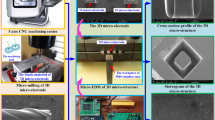Abstract
3D micro-electrode is fitted out by multilayer 2D micro-structures, so the steps inevitably occur in the 3D micro-electrode. When the 3D micro-electrode is used in micro-EDM, steps are replicated onto the surface of the 3D micro-structure, which have an adverse impact on the shape precision of the 3D micro-structure. Focus on this problem, this paper proposed to eliminate the steps of the 3D micro-electrode based on skin effect and point discharge. Then, the paper detailedly researched the impact of machining voltage, machining depth, and processing numbers on the elimination of 3D micro-electrode’s step effect and its micro-EDM results. In order to verify the feasibility of this method, the paper designed a 3D micro-cavity structure which has slopes in the X and Y directions with slope angle of 45°. Finally, under workpiece of 304# stainless steel, pulse width of 800 ns, pulse interval of 4200 ns, machining voltage of 110 V, and machining depth of 650 μm (250 μm larger than the design depth), the step effect of the 3D micro-electrode was effectively eliminated and its micro-EDM result has a dimension error within 7 μm and slope error within 3°.
Similar content being viewed by others
References
Hourmand M, Sarhan A-AD, Sayuti M (2017) Micro-electrode fabrication processes for micro-EDM drilling and milling: a state-of-the-art review. Int J Adv Manuf Technol 91(1-4):1023–1056. https://doi.org/10.1007/s00170-016-9671-4
Yu Z-Y, Masuzawa T, Fujino M (1998) Micro-EDM for three-dimensional cavities-development of uniform wear method. CIRP Ann Manuf Technol 47(1):169–172. https://doi.org/10.1016/S0007-8506(07)62810-8
Rajurkar K-P, Yu Z-Y (2000) 3D micro-EDM using CAD/CAM. Ann CIRP 49(7):127–130. https://doi.org/10.1016/S0007-8506(07)62911-4
Peng Z-L, Wang Z-L, Dong Y-H, Chen H (2010) Development of a reversible machining method for fabrication of microstructures by using micro-EDM. J Mater Process Technol 210(1):129–136. https://doi.org/10.1016/j.jmatprotec.2009.08.002
Tong H, Li Y, Wang Y, Yu D-W (2008) Servo scanning 3D micro-EDM based on macro/micro-dual-feed spindle. Int J Mach Tools Manuf 48(7-8):858–869. https://doi.org/10.1016/j.ijmachtools.2007.11.008
Tong H, Li Y, Zhang L (2016) On-machine process of rough-and-finishing servo scanning EDM for 3D micro cavities. Int J Adv Manuf Technol 82:1007–1015
Yu H-L, Luan J-J, Li J-Z, Zhang Y-S, Yu Z-Y, Guo D-M (2010) A new electrode wear compensation method for improving performance in 3D micro EDM milling. J Micromech Microeng 20(5):055011. https://doi.org/10.1088/0960-1317/20/5/055011
Li J-Z, Xiao L, Wang H, Yu H-L, Yu Z-Y (2013) Tool wear compensation in 3D micro EDM based on the scanned area. Precis Eng 37(3):753–757. https://doi.org/10.1016/j.precisioneng.2013.02.008
Yan M-T, Lin S-S (2011) Process planning and electrode wear compensation for 3D micro-EDM. Int J Adv Manuf Technol 53(1-4):209–219. https://doi.org/10.1007/s00170-010-2827-8
Nguyen M-D, Rahman M, Wong Y-S (2013) Transitions of micro-EDM/SEDCM/micro-ECM milling in low-resistivity deionized water. Int J Mach Tools Manuf 69:48–56
Fu X-Z, Zhang Q-H, Gao L-Y, Liu Q-Y, Wang K, Zhang Y-W (2016) A novel micro-EDM-piezoelectric self-adaptive micro-EDM. Int J Adv Manuf Technol 85(1-4):817–824. https://doi.org/10.1007/s00170-015-7939-8
Zeng Z-Q, Wang Y-K, Wang Z-L, Shan D-B, He X-L (2012) A study of micro-EDM and micro-ECM combined milling for 3D metallic micro-structures. Precis Eng 36(3):500–509. https://doi.org/10.1016/j.precisioneng.2012.01.005
Li L, Gu L, Xi X-C, Zhao W-S (2012) Influence of flushing on performance of EDM with bunched electrode. Int J Adv Manuf Technol 58(1-4):187–194. https://doi.org/10.1007/s00170-011-3357-8
Gu L, Li L, Zhao W-S, Rajurkar K-P (2012) Electrical discharge machining of Ti6Al4V with a bundled electrode. Int J Mach Tools Manuf 53(1):100–106. https://doi.org/10.1016/j.ijmachtools.2011.10.002
Jiang Y, Li Q, Kong L-L, Ping X-L, Zhao W-S (2016) Electrical discharge machining for complex cavity with porous electrode. Procedia CIRP 42:618–622
Shibayama T, Kunieda M (2006) Diffusion bonded EDM electrode with micro holes for jetting dielectric liquid. CIRP Ann Manuf Technol 55(1):171–174. https://doi.org/10.1016/S0007-8506(07)60391-6
Xu B, Wu X-Y, Lei J-G, Cheng R, Ruan S-C, Wang Z-L (2015) Laminated fabrication of 3D micro-electrode based on WEDM and thermal diffusion welding. J Mater Process Technol 221:56–65. https://doi.org/10.1016/j.jmatprotec.2015.02.005
Xu B, Wu X-Y, Lei J-G, Cheng R, Ruan S-C, Wang Z-L (2015) Laminated fabrication of 3D queue micro-electrode and its application in micro-EDM. Int J Adv Manuf Technol 80(9–12):1701–1711. https://doi.org/10.1007/s00170-015-7148-5
Xu B, Wu X-Y, Ma J, Liang X, Lei J-G, Wu B, Ruan S-C, Wang Z-L (2016) Micro-electrical discharge machining of 3D micro-molds from Pd40Cu30P20Ni10 metallic glass by using laminated 3D micro-electrodes. J Micromech Microeng 26(3):035004. https://doi.org/10.1088/0960-1317/26/3/035004
Xu B, Wu X-Y, Lei J-G, Zhao H, Guo D-J Ruan S-C (2017) Micro-ECM of 3D micro-electrode for efficiently processing 3D micro-structure. Int J Adv Manuf Technol 91(1-4):709–717. https://doi.org/10.1007/s00170-016-9825-4
Acknowledgements
The authors are grateful to their colleagues for their essential contribution to the work.
Funding
This work is supported by the National Natural Science Foundation of China (No. 51405306, No. 51575360, No. 51605304 and 51375315), Major Science and Technology Project of Guangdong Province (No. 2014B010131006), China Postdoctoral Science Foundation (No. 2016M601423), Natural Science Foundation of Guangdong Province (No. 2017A030313309 and No. 2016A030310036), the Science and Technology Innovation Commission Shenzhen (No. JCYJ20170412111216258), and the newly introduced teacher launch scientific research project of Shenzhen University (No. 2016037, No. 2017034).
Author information
Authors and Affiliations
Corresponding authors
Rights and permissions
About this article
Cite this article
Xu, B., Wu, Xy., Lei, Jg. et al. Elimination of 3D micro-electrode’s step effect and applying it in micro-EDM. Int J Adv Manuf Technol 96, 429–438 (2018). https://doi.org/10.1007/s00170-018-1632-7
Received:
Accepted:
Published:
Issue Date:
DOI: https://doi.org/10.1007/s00170-018-1632-7



